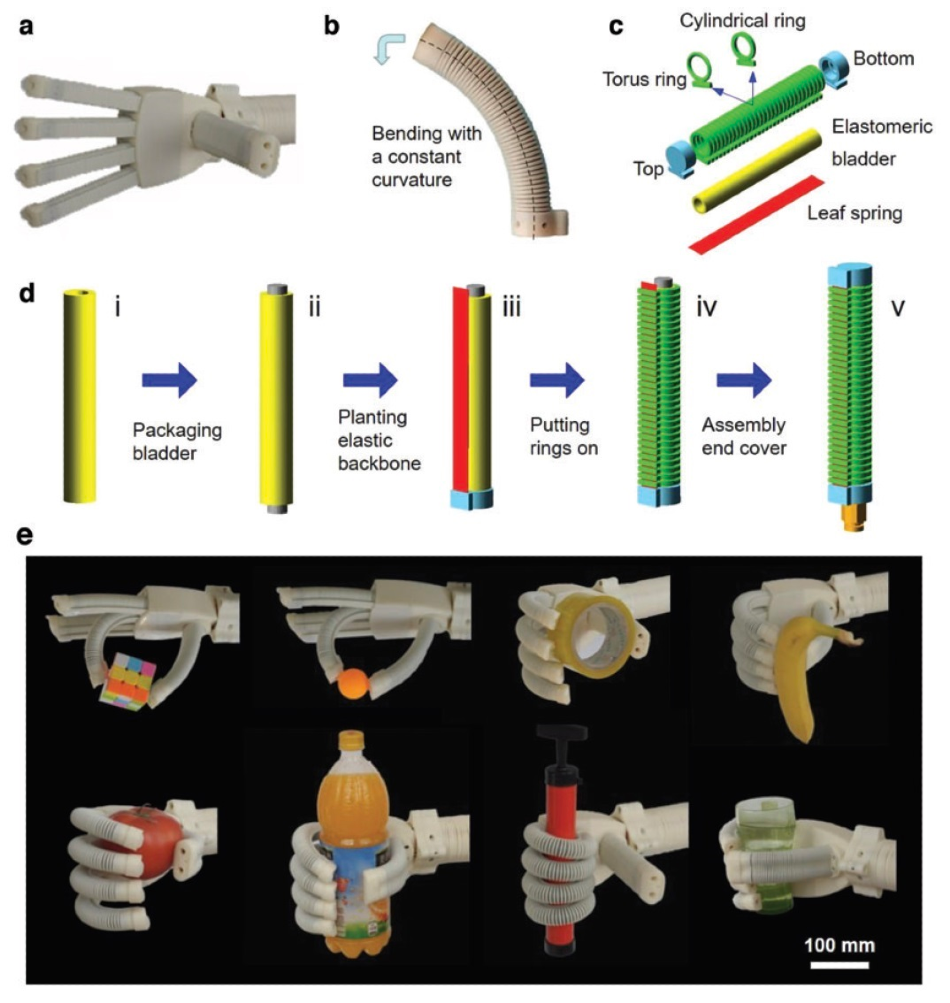Jul 21 2020
At Michigan State University a team of engineers has designed and created an innovative humanoid hand that could help develop a robot with a soft touch.
 The novel humanoid hand design is a soft-hard hybrid flexible gripper that can generate larger grasping force than a traditional pure soft hand. Image Credit: Changyong Cao.
The novel humanoid hand design is a soft-hard hybrid flexible gripper that can generate larger grasping force than a traditional pure soft hand. Image Credit: Changyong Cao.
Robots are often used in industrial settings for tasks that necessitate repeated grasping and manipulation of objects. The end of a robot, a position where a human-like hand is found, is called a gripper or end effector.
The novel humanoid hand design is a soft-hard hybrid flexible gripper. It can generate larger grasping force than a traditional pure soft hand, and simultaneously be more stable for accurate manipulation than other counterparts used for heavier objects.
Changyong Cao, Study Lead Author and Director, Laboratory for Soft Machines and Electronics, Michigan State University
Cao is also an assistant professor in Packaging, Mechanical Engineering, and Electrical and Computer Engineering.
The new study titled “Soft Humanoid Hands with Large Grasping Force Enabled by Flexible Hybrid Pneumatic Actuators” has been published in Soft Robotics.
Soft-hand grippers—mainly used in settings where an object may be light, fragile, and with irregular shape—normally pose various drawbacks: poor stability to grasp unbalanced loads, sharp surfaces, and comparatively weak grasping force to handle heavy loads.
While engineering their new model, Cao and his colleagues considered several human-environment interactions, such as sensitive medical care, fruit picking, etc. They found that certain processes necessitate a safe yet firm interaction with fragile objects. However, a majority of the current gripping systems are not ideal for these purposes.
According to the researchers, the novelty of design led to a prototype that demonstrates the advantages of a lightweight, fast, responsive gripper with the potential to handle a range of tasks that conventionally require gripping systems of different types.
Each finger of the soft humanoid hand is built from a flexible hybrid pneumatic actuator—or FHPA—guided by pressurized air to bend, thus developing a modular framework for movement where each finger moves without depending on the others.
Traditional rigid grippers for industrial applications are generally made of simple but reliable rigid structures that help in generating large forces, high accuracy and repeatability. The proposed soft humanoid hand has demonstrated excellent adaptability and compatibility in grasping complex-shaped and fragile objects while simultaneously maintaining a high level of stiffness for exerting strong clamping forces to lift heavy loads.
Changyong Cao, Study Lead Author and Director, Laboratory for Soft Machines and Electronics, Michigan State University
Cao added this is typically the best of both worlds. The FHPA constitutes both soft and hard components built around an exclusive structural combination of a bone-like spring core and actuated air bladders.
They combine the advantages of the deformability, adaptability and compliance of soft grippers while maintaining the large output force originated from the rigidity of the actuator.
Changyong Cao, Study Lead Author and Director, Laboratory for Soft Machines and Electronics, Michigan State University
Cao considers that the prototype could prove vital in sectors like medical care, surgical robotics, fruit picking, rehabilitation, and automated packaging.
With more scope for further research and development, the researchers hope to integrate their advances with Cao’s recent study on so-called “smart” grippers, by combining printed sensors in the gripping material. The team also aims to more precisely simulate exact human actions by integrating “soft arms” models with the hybrid gripper.
Xiaomin Liu, MSU student Shoue Chen, MSU Foundation Professor Xiaobo Tan from the Department of Electrical and Computer Engineering, and Yunwei Zhao and Dexu Geng from Beihua University are the co-authors of the study.
This study was financially supported, in part, by the U.S. Department of Agriculture-National Institute of Food and Agriculture (1016788), MSU Strategic Partnership Grant, National Natural Science Foundation of China (51275004), and an MSU Startup Grant.
Journal Reference:
Liu, X., et al. (2020) Soft Humanoid Hands with Large Grasping Force Enabled by Flexible Hybrid Pneumatic Actuators. Soft Robotics. doi.org/10.1089/soro.2020.0001.
Source: https://msu.edu/